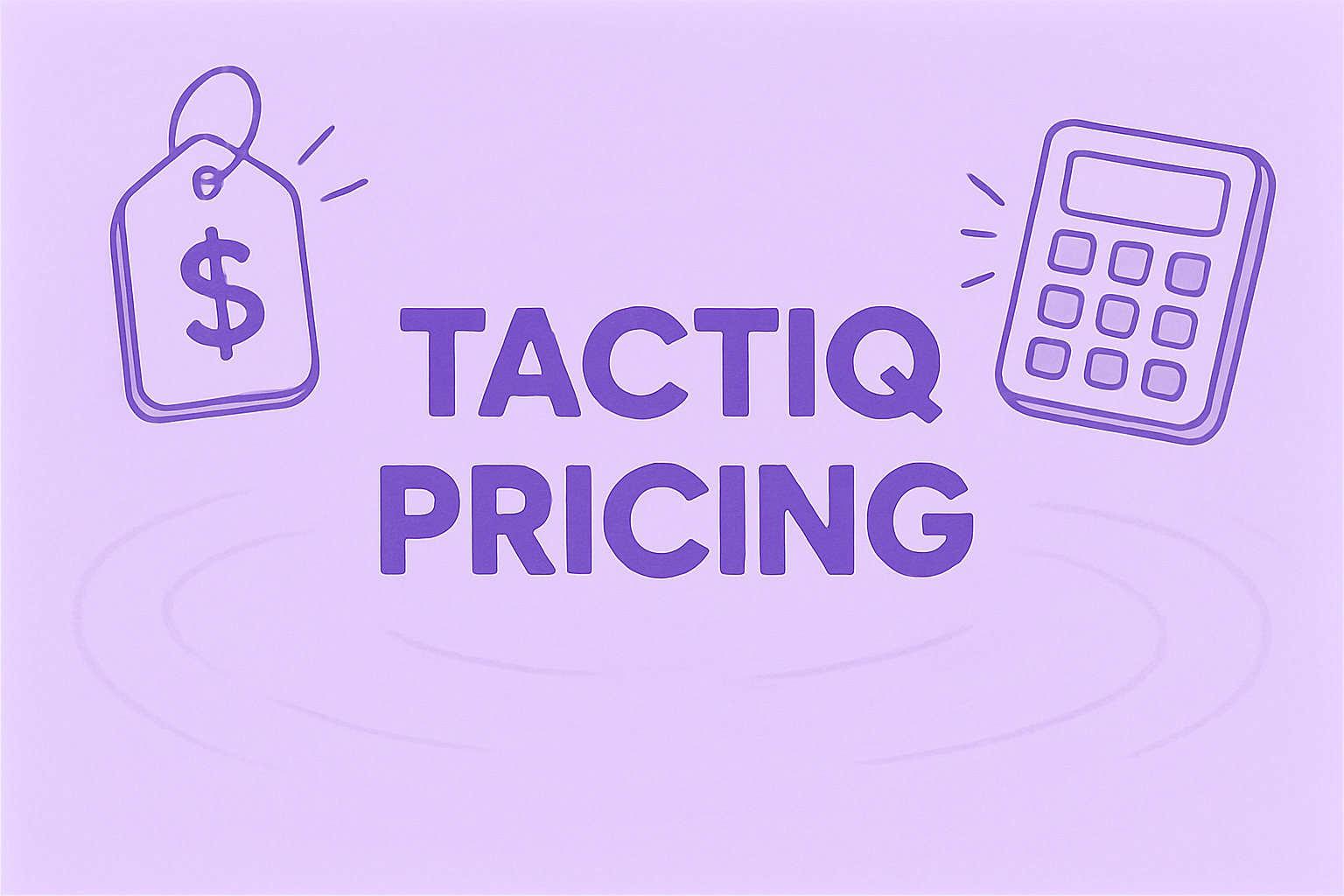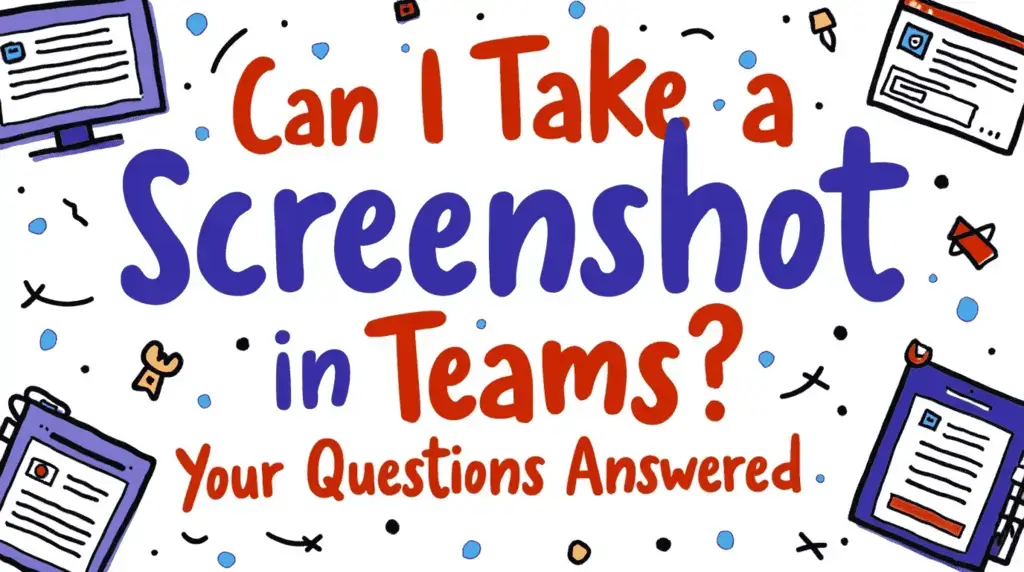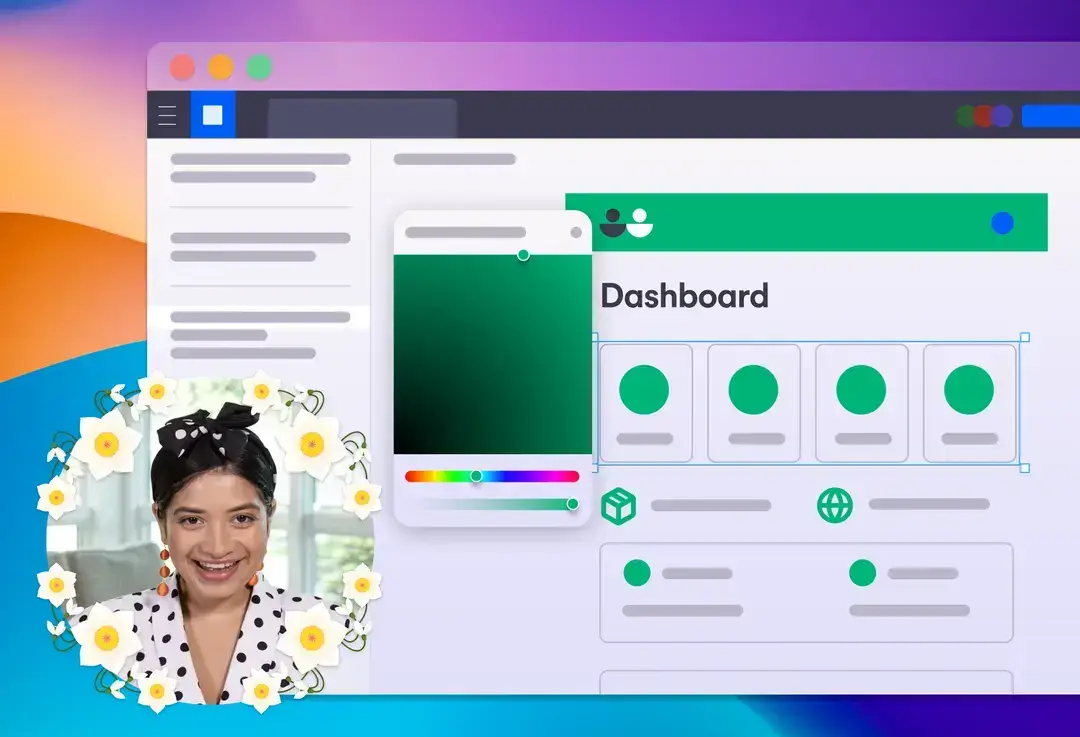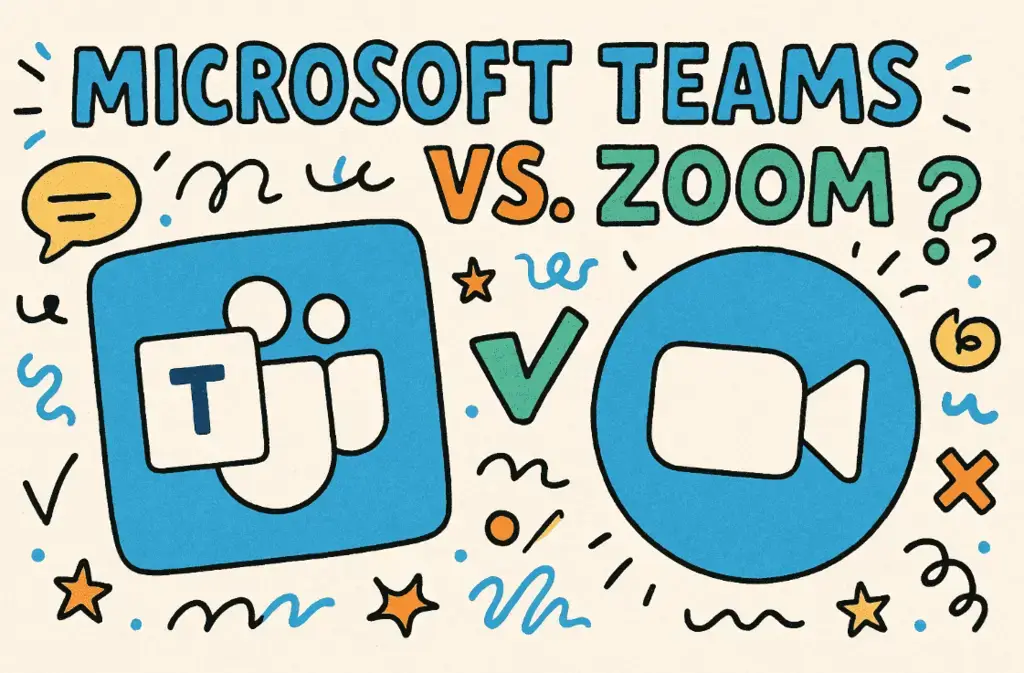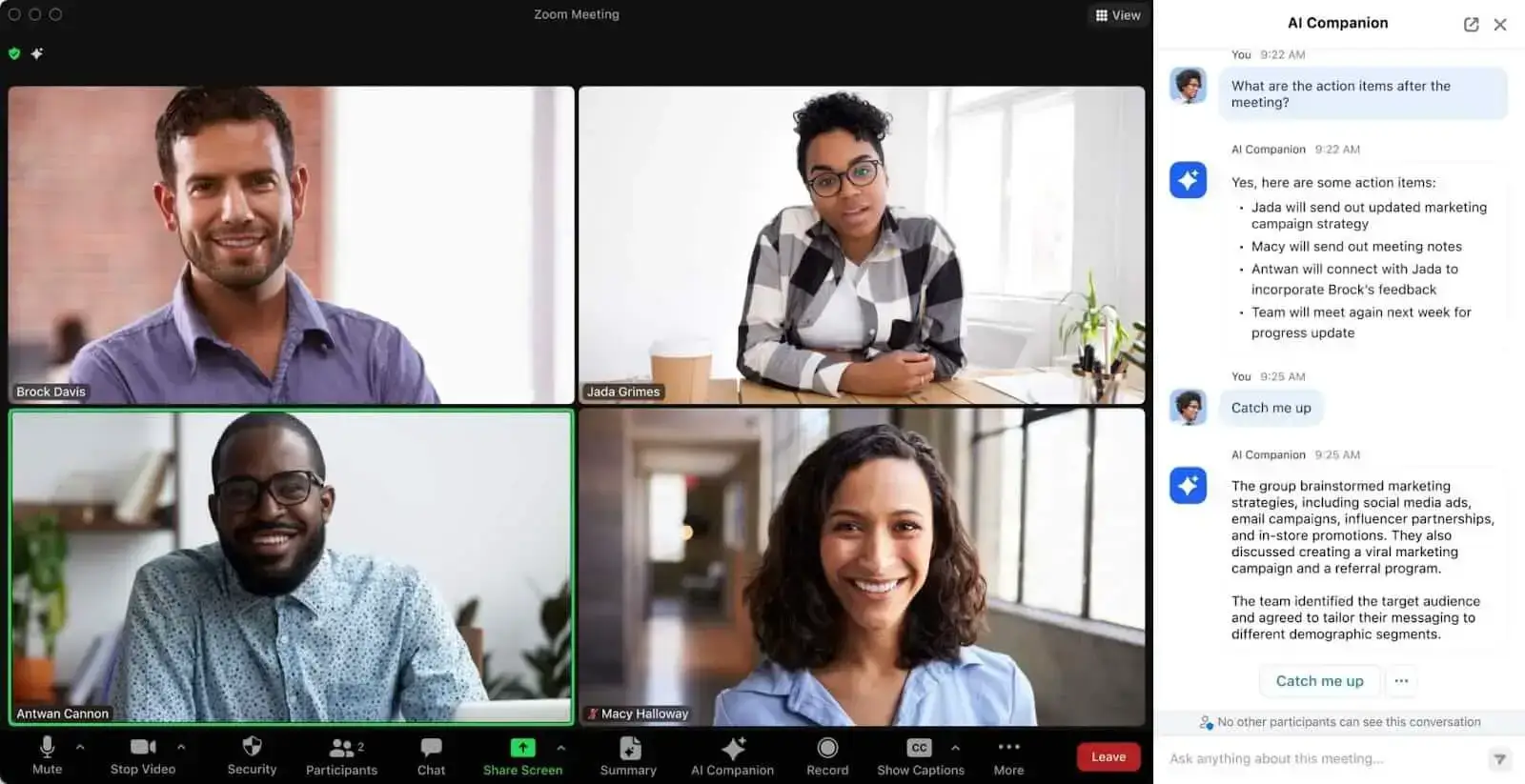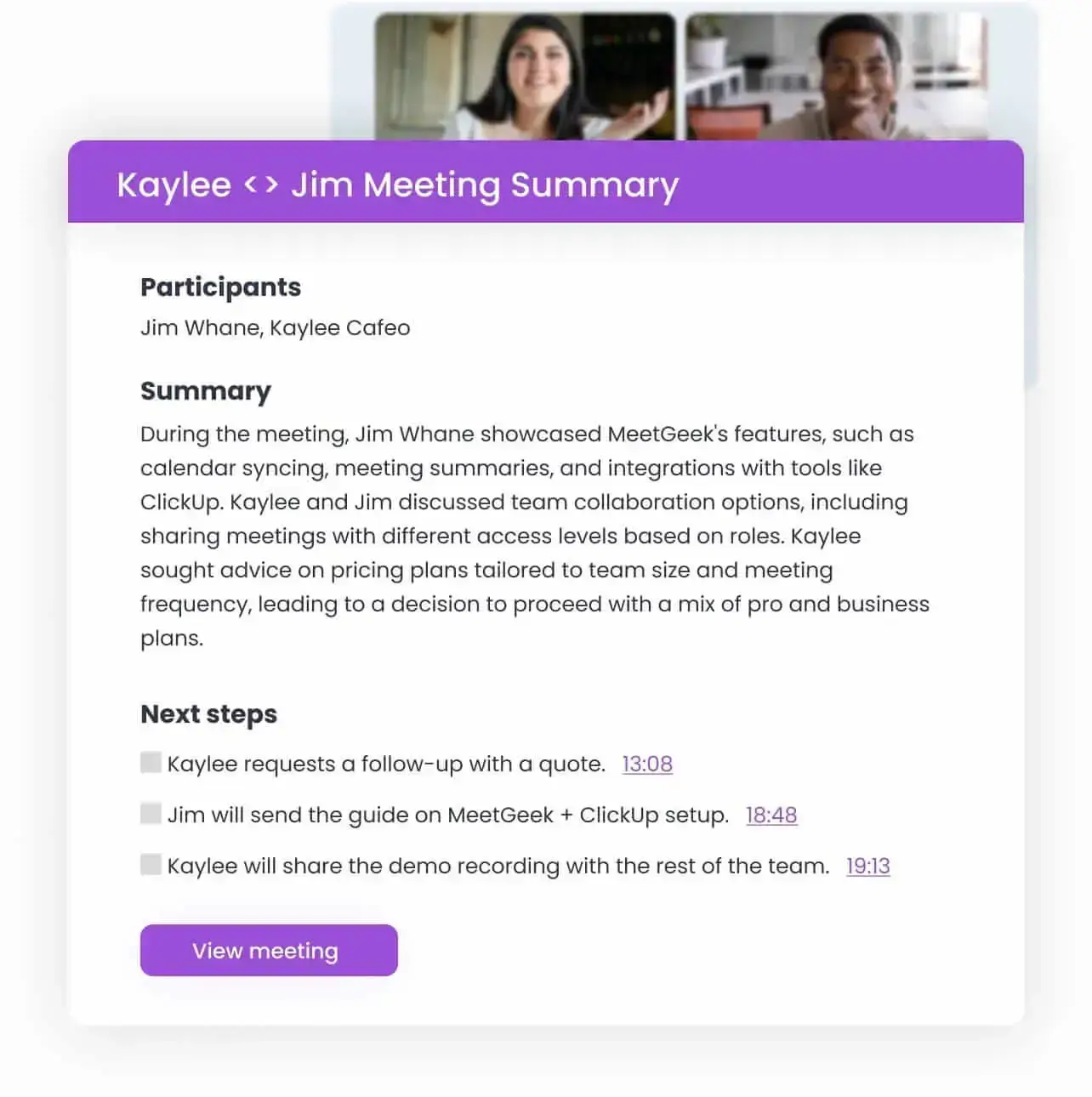12 Effective Sales Team Management Strategies
Discover 12 powerful strategies for managing your sales team more effectively. Boost productivity, enhance teamwork, and drive sales success!

✅ Free meeting recording & transcription
💬 Automated sharing of insights to other tools.

Image source: storyset on Freepik
Is your sales team living up to its potential, or are you struggling to meet quarterly targets?
Managing a sales team can be tough. Challenges like high turnover rates, keeping the team motivated, and the constant pressure to hit rising targets are all too common. Plus, with market conditions and customer expectations shifting constantly, you and your team need to be quick on your feet and eager to learn.
In this article, we'll dive into 12 effective sales team management strategies that will help you not only meet sales targets but also foster a resilient, motivated team.
How Can Sales Managers Lead a Sales Team Effectively?
Leading a sales team effectively requires a blend of strategic thinking, interpersonal skills, and a deep understanding of the sales process.
Here are the skills successful sales managers need to lead their sales team:
- Team management skills
- Sales strategy development and implementation
- Sales team coaching
- Performance evaluation
- Sales forecasting and reporting
A. Team Management Skills
Effective team management starts with understanding the unique dynamics of your sales team. A good manager knows how to foster a culture of open communication and trust, ensuring every team member feels valued and understood.
Additionally, conflict resolution skills are essential. Sales environments are often competitive, which can lead to tensions among team members. Being able to identify, mediate, and resolve these conflicts swiftly and fairly can help you prevent larger issues down the line.
B. Sales Strategy Development and Implementation
Developing and implementing clear and actionable sales strategies is foundational to successful sales management:
- Sales strategy development involves setting realistic goals based on market research and historical data and aligning them with the overall business objectives. Ensure each team member understands these goals and their role in achieving them.
- Sales strategy implementation involves breaking down the strategy into actionable steps and timelines. Regular progress checks and strategy meetings can keep the team on track, allowing you to make adjustments as needed based on performance data and market changes.
C. Sales Team Coaching
Sales coaching is an ongoing process that can increase your team’s performance while helping sales professionals develop soft skills like communication, negotiation, and time management.
However, you need to adapt your process to the needs of each sales rep. For this purpose, role-playing is a great way to enhance sales skills and prepare the team for a variety of sales calls and customer interactions.
D. Performance Evaluation
Regular performance evaluations are key to maintaining a high-performance sales team.
Recognize top performers to set a benchmark and encourage others, but also ensure those struggling receive the support they need to improve.
Keep your evaluations comprehensive, addressing not only target achievements but also how targets were achieved. For an optimal approach, include ethical selling, customer satisfaction, and teamwork should be in the evaluation criteria.
E. Sales Forecasting and Reporting
Accurate sales forecasting and effective reporting are critical for strategic planning and decision-making. For this purpose, CRM tools and data analytics will help you predict future sales trends, allowing you to set realistic targets and adjust strategies to meet changing market demands.
12 Effective Sales Team Management Strategies
To successfully navigate sales management, you must develop a comprehensive approach, combining proven methods with fresh perspectives.
Here are 12 effective sales team management strategies:
- Establish clear goals and expectations
- Clarify your sales process
- Choose your sales team structure
- Hire the right sales reps
- Build a healthy and successful team culture
- Provide continuous training and development opportunities
- Forge sales and marketing alignment
- Implement a sales in systems and processes for sales teams
- Analyze sales metrics
- Establish individual and team performance metrics and KPIs
- Encourage collaborations and teamwork
- Be the leader you always needed
1. Establish Clear Goals and Expectations
Setting clear goals and expectations lays the groundwork for accountability, motivation, and focused effort, all of which are critical for achieving sustained sales performance.
Here's how to establish goals and expectations as a sales manager:
- Create SMART objectives: Start by setting specific, measurable, achievable, relevant, and time-bound goals that align with broader business targets and are tailored to market realities. For example, rather than setting a vague goal like “increase sales,” specify “achieve a 15% increase in sales over the next quarter by expanding into two new market segments.”
- Align personal goals with overall objectives: Ensure that each team member's personal sales goals contribute to the team's overall objectives to instill a sense of accountability and purpose among your reps.
- Communicate expectations clearly: Effective communication is key to ensuring that every team member understands what is expected of them. This includes not only sales targets and outcomes but also the behaviors and processes that the organization values.
- Utilize visual management tools: Dashboards and performance charts are highly effective in keeping goals and expectations top-of-mind. They provide a constant reminder and can quickly show progress towards individual and team targets.
- Revise goals as necessary: Market conditions can change rapidly, and so can the capabilities of your team. Be prepared to adjust goals as needed to stay relevant and challenging. Regularly review the goals in light of new data and team feedback to ensure they remain achievable and motivating.
2. Clarify Your Sales Model
A well-defined, scalable, and consistent sales process is crucial for any sales team's success, particularly as the organization grows. For this purpose, begin by delineating each stage of your sales cycle.
Here are the typical stages of the sales process:
- Prospecting
- Initial contact
- Needs assessment
- Proposal presentation
- Negotiation
- Deal closing
- Follow-up
Then, for each stage, list the key activities that need to be performed, the desired outcomes, and the criteria for progressing to the next stage.
Additionally, offer clear, concise guidelines for each stage of the sales process. This might include detailed descriptions of activities, scripts for sales calls, or criteria for advancing leads through the pipeline.
Make these guidelines accessible, possibly through integration into your CRM or sales enablement tools, enabling your team to apply them consistently and efficiently.
PRO TIP: Identify the best practices that have led to successful sales in the past and standardize these across your team. This could involve creating templates for communications, standardized checklists for assessments, and uniform procedures for data entry and management.
3. Choose Your Sales Team Structure
The structure of your team should align with your business goals, market demands, and the strengths of your team members.
The most common structures for sales teams are:
- Territorial structure: This assigns salespeople to specific geographic areas. It’s beneficial for businesses where face-to-face interactions and local market knowledge are crucial.
- Product-based structure: Salespeople are specialized in specific products or product lines, which is ideal for companies with diverse or complex product offerings requiring deep expertise.
- Market-based structure: Focuses on specific customer segments or industries, suitable for businesses whose products meet the unique needs of different market segments.
- Hybrid structure: Combines elements of the above structures to address more complex sales landscapes, allowing flexibility and specialization.
To determine which one suits your needs best, start by thoroughly assessing your business needs. This includes the types of products or services you offer, your target markets, and your overall business objectives.
Additionally, consider whether your focus is on geographic regions, specific industries, product types, or a combination of these factors. Understanding these dimensions will help you determine the most effective organizational structure to support these goals.
PRO TIP #1: Choose a structure that not only meets current needs but can also scale as your business grows. Flexibility is key, especially in volatile markets or industries undergoing rapid change.
EXAMPLE: A hybrid structure often offers the adaptability needed to respond to changing market conditions, allowing you to reallocate resources quickly between territories, products, or market segments.
PRO TIP #2: Consider the unique strengths and skills of your team. Aligning their skills with the appropriate structure—whether it’s territorial, product-based, or market-based—can leverage their strengths more effectively and increase job satisfaction.
EXAMPLE: For instance, a salesperson with a strong technical understanding of a product might thrive in a product-based structure, while one with excellent regional relationships might be better suited to a territorial approach.
4. Hire the Right Sales Reps
The right sales reps not only drive revenue but also enhance team dynamics and contribute positively to your organizational culture.
However, before launching the hiring process, make sure you fully understand what the role demands and the ideal candidate profile. Define the responsibilities and targets, as well as the skills and attributes that a rep needs to thrive in your specific sales environment.
EXAMPLE: Consider whether the role requires a quick thinker, a relationship builder, or perhaps a problem solver. A thoughtfully crafted job description is key to attracting suitable candidates from the start.
Then, implement a structured interview process that evaluates candidates consistently and fairly. Include a variety of behavioral and situational questions tailored to the real-life challenges and scenarios they will encounter on the job.
Additionally, keep in mind that candidates who share your company's values and integrate well with your team are more likely to stick around long-term. During interviews, delve into their values, work ethic, and motivations to ensure they align with your company culture.
PRO TIP #1: To draw in top talent, offer a competitive compensation package that extends beyond just the base salary. Include performance incentives, bonuses, and commissions to reward high achievers.
PRO TIP #2: Don't overlook benefits like retirement plans, health insurance, and personal and professional development opportunities. These elements are vital for retention, showing your commitment to your team's well-being.
5. Build a Healthy and Successful Sales Team Culture
If you want to have a high performing sales team that drives results, you must acknowledge the importance of having a strong team culture. However, while this may sound easy on paper, there are several things you must consider.
Here is how to build a healthy and successful sales team culture:
- Strong leadership: Effective leadership is foundational in shaping a positive team culture. Leaders should be transparent, communicative, and involved, setting a strong example and fostering an atmosphere of trust and respect.
- Career growth opportunities: Motivate your team by providing clear career progression paths and regular development opportunities. Discuss career goals during one-on-ones and support growth with relevant training programs, making career advancement an attainable goal within your organization.
- Positive environment: Maintain high morale by celebrating successes and promoting a healthy work-life balance. A positive work culture solidifies team spirit and keeps motivation high.
- Define roles and responsibilities: Ensure each team member understands their specific role and how it ties into the team’s dynamic. This eliminates confusion and allows for focused effort, leading to higher sales productivity.
- Let reps play to their strengths: Assign tasks and roles based on individual strengths. Allowing sales reps to focus on what they do best not only boosts performance but also increases job satisfaction and effectiveness.
- Focus on building good sales habits: Encourage practices that lead to long-term success, such as diligent customer follow-ups and consistent self-evaluation.
6. Provide Continuous Training and Development Opportunities
Keeping your sales team competitive and motivated requires you to invest in your team's growth through ongoing training.
Start by assessing the specific training needs of your team. You can do so through performance reviews, feedback sessions, and monitoring sales outcomes. Identify any gaps in skills or knowledge that could be hindering your team from achieving their full potential.
Then, develop a structured sales training program that covers both the basics for newcomers and advanced skills for seasoned professionals. Include modules on product knowledge, sales techniques, customer relationship management, and digital tools that are essential for modern sales processes.
If you want to keep the training engaging and effective, employ a mix of training methods. Host remote or in-person workshops, courses, webinars, and sales simulations.
PRO TIP #1: In addition to organized training, encourage your sales reps to pursue self-led learning. Provide access to learning resources like sales books, industry publications, and online courses to empower reps to take charge of their own growth.
PRO TIP #2: Training should be an ongoing part of your team’s schedule, not just a one-off event. Plan regular intervals for training sessions throughout the year to allow reps to gradually build competence and confidence in new areas.
7. Forge Sales and Marketing Alignment
Aligning your sales and marketing / customer success departments is crucial for boosting business growth and improving customer experiences. When these teams collaborate closely, they can generate leads, close deals, and increase revenue more efficiently.
Here’s how to align your sales and marketing teams:
- Establish shared goals: Establish specific, measurable goals that both teams can pursue together, such as increasing lead conversion rates by a defined percentage within a set period.
- Create joint strategies: Hold joint planning sessions where sales and marketing can exchange insights on market conditions, customer feedback, and effective tactics. This ensures both teams are supporting each other's efforts with coherent strategies.
- Implement integrated tools: Adopt technologies like CRM systems and marketing automation platforms to unify sales and marketing processes. These tools provide insights into customer behaviors and campaign effectiveness, allowing for more targeted and personalized approaches.
- Encourage regular communication: Schedule regular meetings for both teams to discuss activities, celebrate successes, and address challenges.
- Provide cross-training opportunities: Offer cross-training to help each team understand the other's strategies and challenges.
- Measure and refine collaborative efforts: Track success with metrics such as lead quality, conversion rates, and customer acquisition costs to ensure both teams are effectively aligned and achieving shared objectives.
- Document the process: It goes without saying that to streamline the entire process, you must document every conversation you’ll have with other departments — yes, even in-person conversations. MeetGeek’s mobile app records your live interactions, delivering accurate meeting recordings and transcriptions straight to your account, all in a matter of minutes.

This way, no matter how you prefer to have your conversations, you and your team never miss out on critical knowledge again.
8. Invest in Systems and Processes for Sales Teams
To achieve sustained growth and enhanced efficiency, you must upgrade your sales infrastructure accordingly.
First, review and map each step of your sales process, from lead generation to post-sale follow-up. Identify any inefficiencies and streamline these areas. For example, if your proposal approval process is slowing down sales, explore ways to automate or simplify this step.
Then, determine which systems will most directly boost productivity and effectiveness.
Here are the systems sales teams rely on the most:
- Customer relationship management (CRM) software: Essential for tracking customer interactions, managing sales pipelines, and automating routine tasks
- Sales automation tools: Useful for automating repetitive tasks such as email follow-ups, meeting scheduling, and sales updates
- Data analytics platforms: These platforms help analyze sales data to inform strategic decisions and improve forecasting
- Meeting automation platforms: Virtual AI meeting assistants like MeetGeek enhance the productivity of sales teams by streamlining the way meetings are managed and integrated into daily workflows.
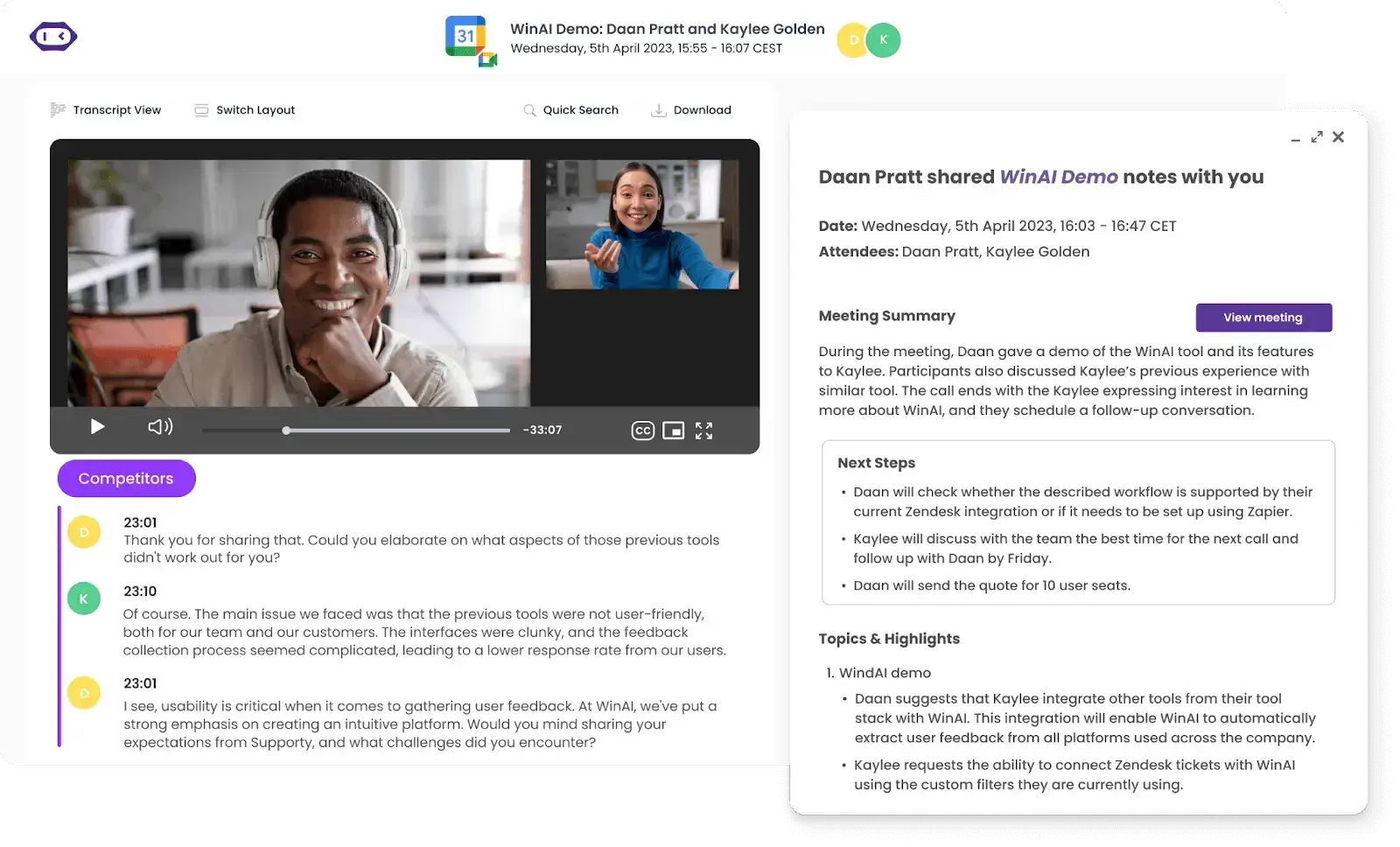
Here’s how MeetGeek can transform your sales meetings into a powerhouse of efficiency and collaboration:
- Meeting recording and transcription: With MeetGeek, every sales meeting is recorded and transcribed automatically. This is incredibly valuable for team members who can’t attend in real time, allowing them to review the discussions at their convenience and stay aligned with the team's objectives.
- Key point and action item detection: MeetGeek utilizes advanced AI to detect and highlight the key points and action items during meetings. This helps sales teams focus on what matters most, enabling them to quickly identify the essential outcomes and next steps without needing to sift through hours of recordings.
- Shareable meeting summaries: After each meeting, MeetGeek generates concise, shareable summaries that can be easily distributed among the team. These summaries provide a quick way for any team member to catch up on missed meetings or review discussions, ensuring everyone is up to speed.
- Integrations with CRM and collaboration tools: MeetGeek seamlessly integrates with a variety of collaboration and CRM tools, ensuring that the insights from your meetings are quickly integrated into your workflow.
- Searchable transcripts: This feature saves time and enhances productivity by allowing team members to directly access the information they need without replaying entire recordings.
- Time-stamped notes and comments: MeetGeek’s time-stamped notes and comments enable team members to engage in asynchronous discussions and provide feedback on specific parts of the meeting.
- Efficient follow-ups: MeetGeek enables you to set up workflows that email meeting participants AI-generated summaries, complete with action items and key takeaways, in only minutes after the conversation ends.
NOTE: Continuously assess the effectiveness of your systems and processes. Regularly updating your systems ensures they keep pace with your business needs and continue delivering value.
9. Analyze Sales Metrics
The success of your overall sales strategy hinges on developing a deep understanding of key sales metrics. The conversation intelligence tools provided by MeetGeek can greatly enhance your efforts in this direction and guide the entire process.
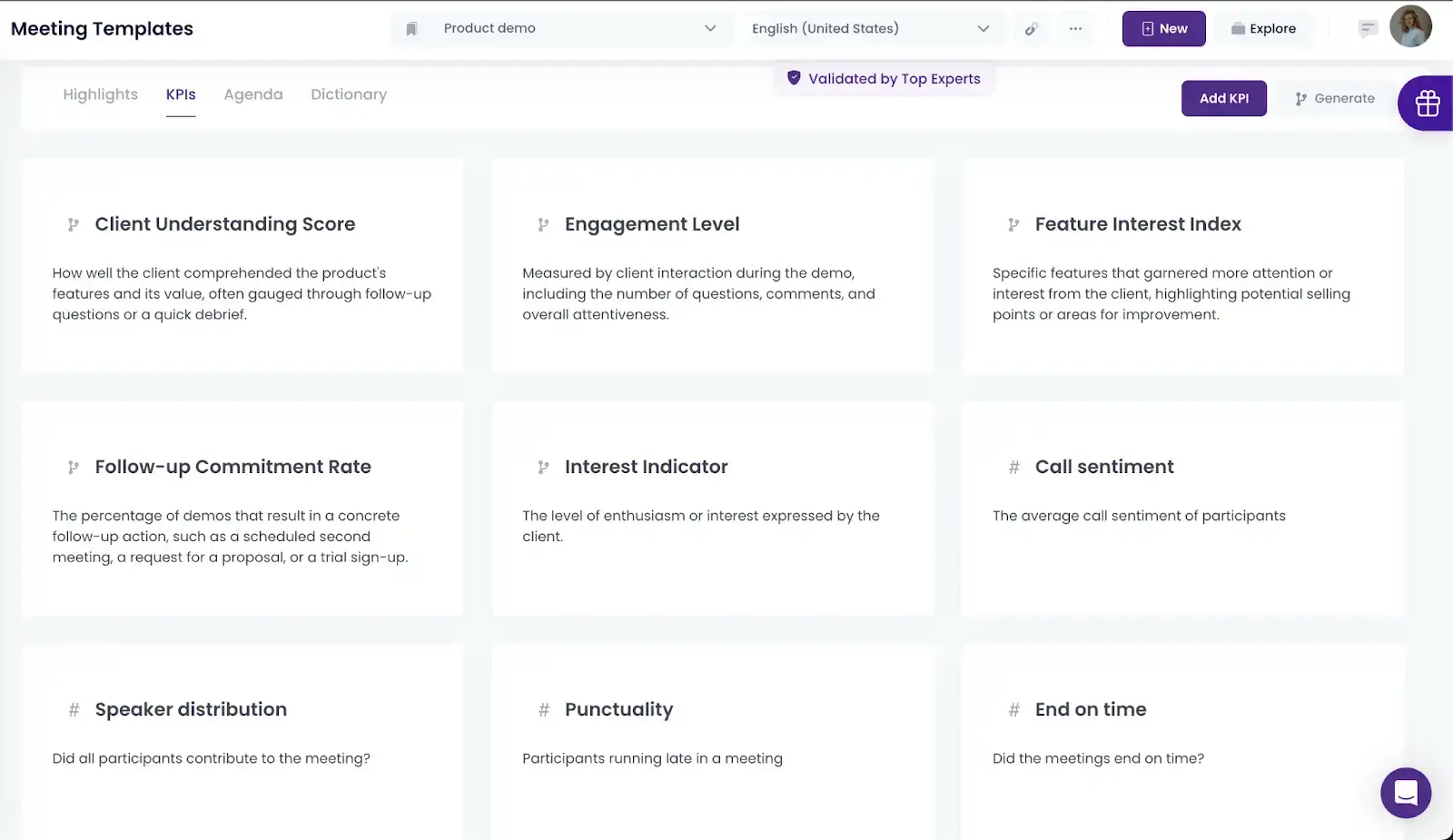
Begin by identifying which metrics are most critical to your sales objectives.
Here are some common sales metrics:
- Sales revenue: Tracks the total earnings from sales, which is essential for understanding overall performance
- Conversion rates: Measures how well potential leads turn into customers, highlighting the effectiveness of sales pitches and processes
- Average deal size: Provides insights into the types of deals your team is closing, which can help in targeting efforts and forecasting
- Sales cycle length: Insights into how long it takes to close a deal can help in streamlining processes and training
- Customer acquisition cost (CAC): Knowing the cost of acquiring new customers helps you evaluate the efficiency of your sales and marketing efforts.
PRO TIP #1: Keep your data collection efforts consistent and systematic. This allows you to look for trends and patterns in the data over different periods.
EXAMPLE: Analyzing sales revenue month-over-month can reveal seasonal fluctuations or the impact of your marketing campaigns. Similarly, tracking conversion rates over time can help pinpoint when changes in the sales process improve or hinder performance.
PRO TIP #2: For even deeper insights, break down your data by different criteria such as product lines, customer demographics, or sales territories. This may reveal which areas are performing well and which require more attention.
EXAMPLE: For instance, if one region consistently shows higher sales revenue, it might be worth investigating what strategies are working there and whether they can be applied elsewhere.
Let your analysis guide strategic decisions. If your average deal size is smaller than desired, you might decide to shift focus towards higher-value clients or adjust your pricing strategies. Similarly, a high CAC might lead you to refine your marketing strategies or streamline your sales processes to reduce costs.
10. Establish Individual and Team Performance Metrics
For sales teams to truly excel, having clear and actionable performance metrics is essential.
Here are the individual and team key performance indicators (KPIs) you’ll need to set for your sales team:
- Time spent selling: Assess how much time sales representatives actually spend in direct sales activities versus other tasks like admin work or meetings. Aim for a balance that allows enough time for essential non-sales tasks without detracting from customer-facing opportunities.
- Opportunity win rate: This KPI calculates the percentage of sales opportunities that convert into actual sales. Analyzing why deals are won or lost can provide critical insights that drive future improvements.
- Lead response time: As promptness often equates to efficiency and reliability in the customer's eyes, you must track how quickly sales reps respond to leads. Encourage practices that enable faster responses, such as mobile CRM access or automated alert systems for new inquiries.
- Cost per acquisition: Calculate the total cost of acquiring a new customer, including all marketing and sales expenses. Regularly review and adjust strategies based on which channels and tactics deliver the lowest CPA.
- Customer lifetime value: This is a forecast of the total value a business will derive from their entire relationship with a client. Increasing CLV is about not only making initial sales but also fostering repeat business and customer loyalty.
PRO TIP: Performance metrics should not be set in stone. Regularly review them to ensure they are still relevant and adjust them based on current sales results, changing business needs, and market conditions. This might mean redefining KPIs or adjusting targets to keep them challenging yet achievable.
11. Encourage Collaboration and Teamwork
As a sales team leader, your effectivenessr elies on your success in creating an engaging and cooperative work environment.
Here are the factors that encourage collaboration and teamwork among your sales team:
- Success stories
- Accountability groups
- Cross-training and mentorship programs
- Knowledge collaboration
A. Success Stories
When a sales rep closes a significant deal or successfully navigates a complex sale, highlight their accomplishment in your next team meeting.
Invite the entire team to share their strategies and learnings, turning their success into a learning opportunity for everyone. This not only helps you recognize individual achievements but also aids in standardizing effective sales tactics across your team.
B. Accountability Groups
Form small groups within your team to foster mutual support and accountability. Encourage these groups to meet regularly to set personal goals, share progress updates, and discuss challenges.
A peer support system like this can provide motivation and practical advice, helping each member stay focused and proactive about their targets.
C. Cross-Training and Mentorship Programs
Develop cross-training programs where team members can teach each other different aspects of the sales process, leveraging each other's strengths.
Additionally, set up mentorship pairings between experienced salespeople and new hires straight from the onboarding stage. These programs not only broaden individual skill sets but also strengthen connections within the team, helping aspiring sales leaders thrive within a collaborative environment.
D. Knowledge Collaboration
Encourage your team to share insights and successful strategies by setting up digital knowledge-sharing spaces or communication tools.
Choose a platform or tool—like a shared drive or project management software—that is accessible to everyone. It should be user-friendly and available to all sales reps, regardless of their location.
Encourage every team member to contribute to this shared repository. Provide instructions on how to upload relevant documents, notes, and action items following each conversation or meeting.
In an effort to help, MeetGeek offers a unified meeting repository where you can store all your sales meeting recordings, transcripts, and details. This feature makes it easy to find specific meetings without having to search through local hard drives or other storage solutions.
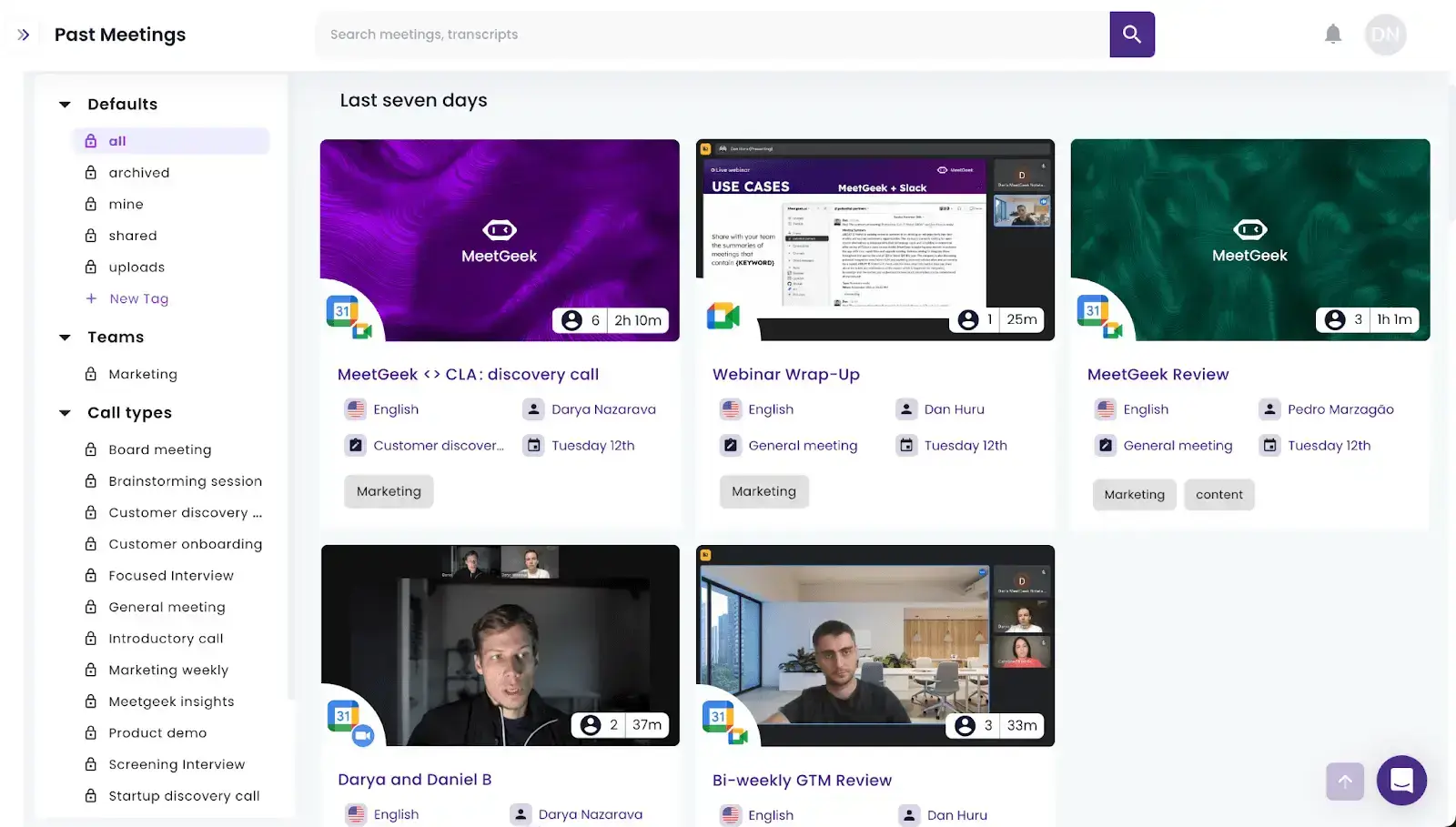
PRO TIP: MeetGeek enables you to easily share your internal or external meetings with the rest of your sales team members automatically, through custom email workflows, or manually, via link.
12. Be the Leader You Always Needed
Lastly, effective leadership in sales team management is all about inspiring and supporting your team in ways that you once needed from a leader.
Let’s discuss how you can become the leader you always needed!
A. Set Up One-On-Ones
One-on-one sessions provide a private space for open dialogue, where you can understand individual challenges, discuss career aspirations, and give personalized guidance.
Schedule these meetings consistently—whether weekly or biweekly—to ensure you're actively involved in each team member’s professional development. Use this time not only to track progress but also to build trust and rapport, making it clear that you’re invested in their success as much as the team's.
B. Establish Communication Channels
Establish distinct channels for different types of communication, such as direct messaging for quick updates, email for detailed information, and regular team meetings for collaborative discussions.
Make yourself available and approachable, and ensure that your team knows how and when they can reach you
C. Give Sales Reps Detailed Feedback
Feedback is necessary for growth, but only if it inspires further action. Focus on providing detailed feedback that helps your sales reps understand what they are doing well and where they need to step up.
Avoid vague comments, incorporating specific examples from recent work to back up your evaluation. Offer constructive criticism in a way that is supportive and empowering, and always pair it with suggestions for improvement or resources for skill enhancement.
Remember, the goal of feedback is to motivate and develop your team, not just to evaluate them.
Things to Avoid as a Sales Manager
Effective sales management is as much about avoiding common pitfalls as it is about resorting to some best practices.
Here are the things to avoid as a sales manager:
- Micromanagement: Overseeing every detail of your sales reps’ work can undermine their confidence and stifle initiative. Great sales managers let their team handle their responsibilities and focus on guiding them only where necessary.
- Ignoring data: Data-driven decisions are key to understanding market trends, customer behaviors, and team performance. Ignoring these can lead to missed opportunities and strategies that are out of sync with current market dynamics.
- Failure to adapt: The sales environment is constantly evolving, and sticking rigidly to old methods can be detrimental. Always leave room for new trends, technologies, and practices that can enhance your sales processes. Encourage innovation and be open to trying new approaches.
- Not dealing with underperformance: Avoiding shortcomings can lead to bigger problems down the line, affecting team morale and overall results. Address underperformance directly and constructively to help underperforming team members improve. Consider whether changes in role or responsibilities might be necessary.
- Neglecting personal well-being: Neglecting your own health and work-life balance can lead to burnout, which compromises your effectiveness and can trickle down to your team. The best sale smanagers prioritize self-care, encourage work-life balance, and lead by example. A healthy leader inspires a healthy team.
Manage Your Sales Team Effectively with MeetGeek!
In conclusion, while implementing these strategies won't happen overnight, the effort you put into refining your approach to sales management can yield substantial rewards in team morale, customer satisfaction, and ultimately, sales performance.
As you move forward, remember that the most successful sales organizations are those who continuously seek out new tools and methods to stay ahead.
In line with adopting innovative tools and strategies, consider exploring MeetGeek, our AI meeting automation platform designed to enhance your team’s productivity by automating meeting notes, tasks, and follow-ups.
MeetGeek ensures no critical information is lost, and every action item is captured, making your sales meetings more effective and freeing up more time for your team to focus on selling.
Try MeetGeek for free and see the difference it can make in your sales management approach!
.avif)






















